Stone Cliff, WV
Introduction
Text-to-speech Audio
Images
Stone Cliff’s railroad depot.
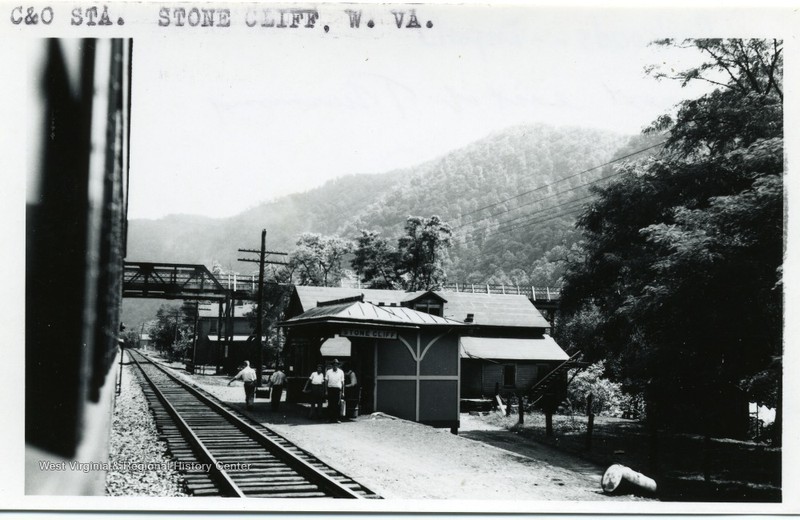
Several workers and a donkey loading and unloading fuel from Stone Cliff’s coke ovens.
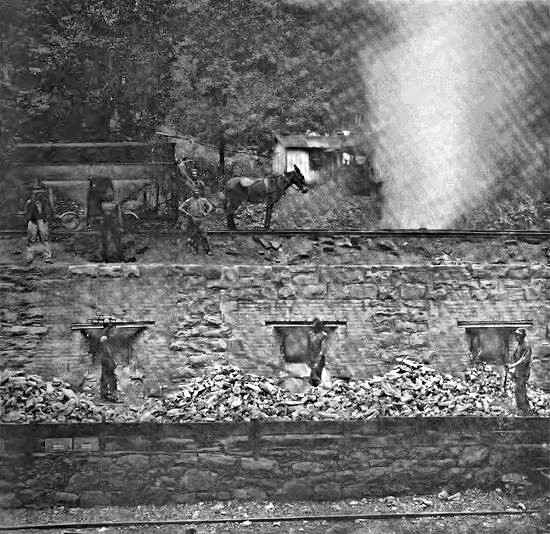
Houses in Stone Cliff, 1930s.
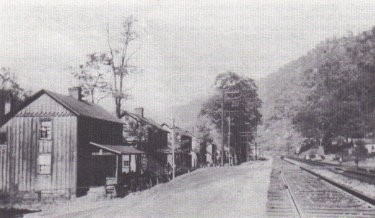
A group portrait of men in Stone Cliff. The wide range of vestments indicate that there are several socio-economic classes represented.
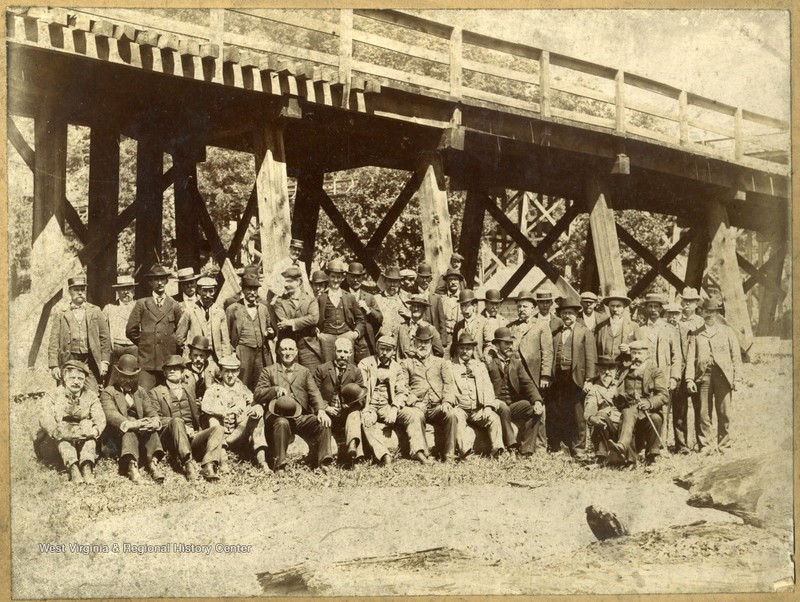
A piece of cable leftover from the mining days
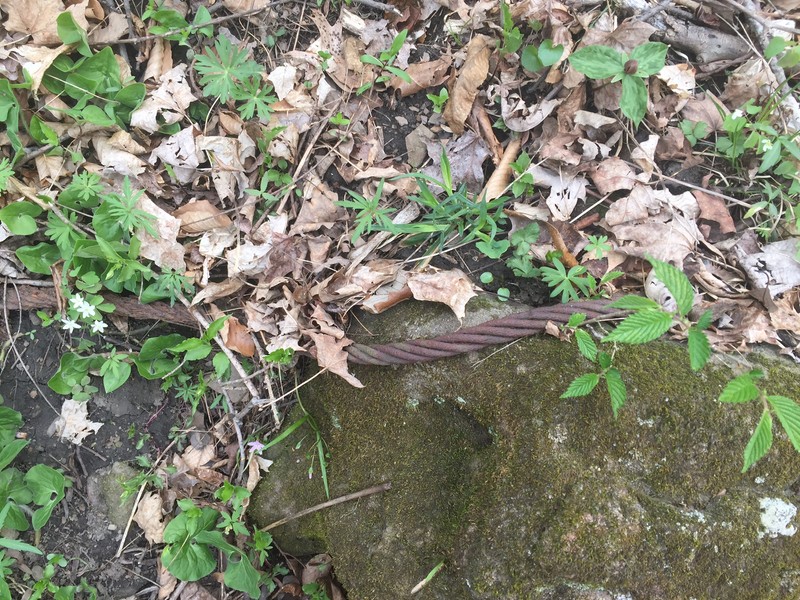
Backstory and Context
Text-to-speech Audio
Established by Noah Jenkins and J.H. Bramwell around 1882, Stone Cliff was among the earliest coal towns in the gorge. Bramwell later went on to establish the community of Bramwell in Mercer County in 1888. As was typical of the mining operations within the gorge, the mines were located well above the town. The people of Stone Cliff worked in the two drift mines, one into the Fire Creek seam and the other three hundred feet above the first in the Sewell seam, opened by Jenkins and Bramwell. Coal was moved from the mine to the Chesapeake and Ohio Railroad or the abundant coke ovens near the town by means of a tramway and monitor cars.
The town site is located at the eastern end of the Stone Cliff bridge, originally constructed in 1928 to replace a ferry that had operated at the same location. The bridge was rehabilitated in 2003. Immediately to the left, after crossing the bridge was the location of Stone Cliff. The town was constructed like many other towns found along the New River, with homes on either side of the main line. Robert J. Jackson and James Laprade, former residents of Stone Cliff, remember houses on either side of the track, one side for African-Americans and the other for whites. Even though both men are African-Americans and grew up in a segregated society, neither recall overt racism in their daily lives. Despite this, racial discrimination pervaded life for Black miners and their families throughout the New River Gorge coal fields. One of the most persistent challenges for Black families in the area was the lack of local educational opportunities. Stone Cliff offered a one room school with instruction through eighth grade for children of the white miners. Despite African Americans composing no less than 40% of the community in the 1890s and 55.9% of the population by 1900, Black children were forced to walk a mile upriver to Claremont in an effort to obtain an education. In addition to the school, the town was home to an African American church located between Stone Cliff and Thurmond. This church hosted the annual travelling minstrel show of Silas Green. This was a popular show among all the denizens of the gorge
The homes occupied by all miners lacked running water, indoor plumbing, and electricity. Water for drinking came from a spring, water for other purposes came from the river. Cooking was done on a coal burning stove. In the winter, heat was also provided by coal. These homes were the typical Jenny Lind style home common to coal towns with a twist.The structures at Stone Cliff were four rooms, two downstairs and two upstairs. Many of them had a lean-to type structure on the rear used for cooking and clothes washing in the summer months. The home was heated by a central chimney that featured an opening in each of the four rooms. Housing in Stone Cliff was without electricity into the late 1940s or early 1950s. The lack of electricity in the homes is not an indication that the town was without it. On the contrary, Stone Cliff was home to a power station that burnt coal from 6 A.M. to 6 P.M. for use in the extraction of coal.
Mr. Jackson stated the town was not home to coal miners exclusively. Railroad men, like his father and grandfather, and their families also lived within the area of Stone Cliff. The houses of railroad workers were typically two rooms whereas the homes of miners were four. Many of the railroad men, “…worked some extra time there (mines),” so they could live in the larger miner’s house. Stone Cliff was also the location of a turntable for the C&O Railroad, due to its proximity to Thurmond. The remains of this are still intact There are a number of stone foundations of the buildings left for the explorer to uncover. Stone Cliff was also home to sixty coke ovens at one time. These ovens were used to the volatile material from the coal. The result is a product that burns extremely hot and is desirable in the steel industry. Amazingly, Mr. Jackson related stories of people coming from out of town to work in the mines and rather than return to their homes when the mines were not open they would stay in the coke ovens. The ovens were not in use at this time. As he recalled there were no places close by for the workers to stay so they would set up housekeeping in the ovens themselves.
At its peak, the population of Stone Cliff was 520 people in 1910. Due to the mine operations trading hands a number of times during the life of Stone Cliff, the population continued to fall in the following decades. By the late 1920s there were less than fifty men employed in the mine. Mining continued into the 1940s by the Pugh Coal Company. The post office established in 1880 ceased operation in 1948. Without economic prospects to sustain the town, Stone Cliff was abandoned in the late 1940s and left to decay. Only a few foundations and the railroad tracks remain today.
Sources
"African American Life in a Coal Camp: Nuttallburg - New River Gorge National River (U.S. National Park Service)." NPS.gov Homepage (U.S. National Park Service). Last modified March 21, 2017. https://www.nps.gov/neri/planyourvisit/african-american-life-in-a-coal-camp-nuttallburg.htm.
Bragg, Melody. Thurmond and Ghost Towns of the New River Gorge. Glen Jean, WV. Gem Publications, 1995.
Cavalier, John. Panorama of Fayette County. Parsons, WV. McClain Print Company, 1985.
EDAW, Inc.. Riveranna Archaeological Services, LLC.. Jordan, Norman. Traditional Associations of African Americans with New River Gorge National River. 2009. Prepared for National Park Service; New River Gorge National River
Hager, Beth "Bramwell." e-WV: The West Virginia Encyclopedia. 12 February 2013. Web. Accessed May 2, 2018. https://www.wvencyclopedia.org/articles/641
Peters, J. T. Carden, H. B. History of Fayette County West Virginia. Charleston, WV. Jarrett Printing Company, 1926. Reprinted 1972 by McClain Printing Co. Parsons WV
Stahlgren, Lori et al. Historical Archaeological Survey: New River Gorge National River and Gauley River National Recreation Area. Lexington, KY. Kentucky Archaeological Survey, 2007.
"STONE CLIFF, WV." APPALACHIAN COALFIELDS. Accessed May 2, 2018. http://www.coalcampusa.com/sowv/river/stonecliff/stonecliff.htm.
Workman, Michael Edward "Coke Making." e-WV: The West Virginia Encyclopedia. 04 February 2011. Web. Accessed May 2, 2018. https://www.wvencyclopedia.org/articles/1386
Workman, Michael E. Maddex, Lee R. Bonenberger, Dan J. New River Gorge National River: Historic Resource Study NERI-02-038 HRS. WV. Institute for the History of Technology & Industrial Archaeology, 2005. Report submitted to New River Gorge National River US Dept. of Interior, National Park Service Cooperative Agreement No. H0001010032
Veazey, Oscar A. First Annual Report of the State Inspector of Mines to the Governor of the State of West Virginia for the Year 1883. Wheeling: Charles H. Taney, 1884.
“Chesapeake and Ohio Railroad Depot, Stone Cliff, W. Va.” West Virginia & Regional History Center. Accessed May 13th 2021. https://wvhistoryonview.org/catalog/026122.
Coal Camp USA. Accessed May 13th 2021. http://www.coalcampusa.com/sowv/river/stonecliff/stonecliff.htm.
Coal Camp USA. Circa 1930. Accessed May 13th 2021. http://www.coalcampusa.com/sowv/river/stonecliff/stonecliff.htm.
“Group Portrait of Men, Stone Cliff, W. Va.” Circa 1880-1900. West Virginia & Regional History Center. Accessed May 13th 2021. https://wvhistoryonview.org/catalog/036498.
